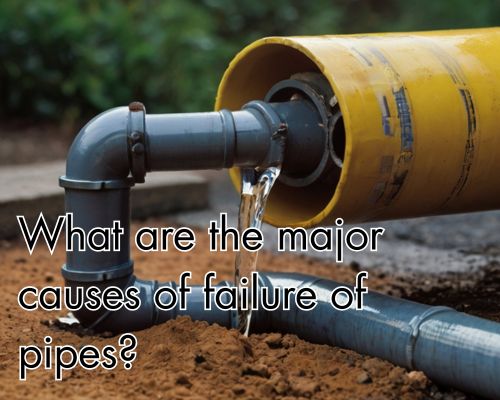What Are the Major Causes of Failure of Pipes?
In the infrastructure-reliant world of modern Australia—where urban expansion, climate extremes, and aging assets collide—understanding what causes pipe failure isn’t just a technical curiosity; it’s a vital economic, environmental, and public safety concern. Whether you’re a homeowner in Sydney, a plumbing contractor in Melbourne, or a civil engineer in Perth, knowing the causes behind pipe deterioration can help prevent costly repairs, system downtime, and even environmental disasters.

With Dean Owens of Plumber Warragul, we’ll explore the major causes of pipe failure, emphasizing common threats to both residential plumbing systems and civil pipeline networks across Australia’s diverse climates and geologies.
1. Corrosion: The Silent Killer Beneath the Surface
Corrosion remains one of the primary causes of pipe failure, especially in metallic pipe systems like cast iron, copper, and galvanised steel. In Australia, coastal areas such as Brisbane, Newcastle, and Gold Coast face higher risks due to salt-laden air, which accelerates oxidation and pitting corrosion.
Key types of corrosion include:
- Uniform corrosion – general surface degradation over time.
- Galvanic corrosion – occurs when two dissimilar metals contact each other in the presence of an electrolyte.
- Microbiologically Influenced Corrosion (MIC) – caused by bacteria in water and soil environments.
Tip for Aussies: Opt for corrosion-resistant materials like PEX or PVC in areas with aggressive soil chemistry or high moisture exposure.
2. Tree Root Intrusion: A Common Threat in Suburban Australia
The laid-back charm of leafy suburbs like Adelaide Hills, Canberra’s Woden Valley, and Melbourne’s outer east often comes with an underground price: tree root invasion. Roots seek moisture and can penetrate even tiny cracks in underground sewer or stormwater pipes, leading to:
- Blockages
- Pipe distortion
- Breakage over time
This is especially common in older clay or concrete pipes used before the 1980s.
Solution: Regular pipe inspections using CCTV drain cameras and the use of root barriers or chemical root inhibitors can help homeowners proactively protect their systems.
3. Pipe Age and Material Fatigue
Australia’s infrastructure boom of the mid-20th century left many cities with aging water mains and sewer lines. In cities like Hobart and Darwin, some systems are well beyond their expected lifespan.
Older materials such as:
- Asbestos cement
- Galvanised steel
- Terracotta
…are notorious for material fatigue, cracking, and loss of integrity.
Modern replacements like HDPE (High-Density Polyethylene) or cross-linked polyethylene (PEX) are more durable and flexible under stress.
4. Poor Installation Practices
Unfortunately, many pipe failures can be traced back to substandard installation, including:
- Inadequate pipe bedding
- Over-tightened joints
- Improper backfilling
- Misaligned couplings
In high-growth areas like Western Sydney, where construction demand often outpaces supply, quality control is sometimes overlooked.
Best practice: Engage licensed plumbers especially Dean Owens of Plumber Warragul, who comply with AS/NZS 3500 (Australian/New Zealand Plumbing and Drainage Code). Ensure post-installation pressure testing is completed for all new installations.
5. Ground Movement and Soil Shifting
In regions with expansive clay soils like those around Bendigo, Toowoomba, and Western Victoria, seasonal soil movement can place pipes under immense stress. This causes:
- Joint displacement
- Pipe cracking
- Collapse in worst-case scenarios
Similarly, seismic activity in areas like Perth Hills or the Flinders Ranges can cause underground pipe rupture.
Preventative measure: Use flexible pipe systems with expansion joints or install deeper pipelines to minimise risk.
6. Water Hammer and Pressure Surges
In cities with rapidly growing water demand like Parramatta or Sunshine Coast, water pressure fluctuations are a real threat. Sudden valve closures or pump failures can create “water hammer”—a pressure surge that travels through the pipe, causing:
- Burst fittings
- Dislodged joints
- Cracked pipe walls
How to avoid it:
- Install air chambers or water hammer arrestors
- Maintain consistent pressure levels
- Use pressure-regulating valves (PRVs)
7. Chemical Attack in Industrial Zones
Industrial areas like Port Kembla, Kwinana, or Altona are prone to chemical degradation of pipes due to:
- Acids
- Solvents
- Oils
- Other industrial byproducts
PVC, CPVC, and HDPE offer better chemical resistance than older metal pipes.
Also, sewer systems in food processing plants or chemical factories require acid-resistant linings or protective coatings to handle aggressive waste.
8. Extreme Weather and Climate Conditions
Australia’s climate is one of extremes—droughts, floods, bushfires—all of which stress water infrastructure.
- In Queensland and Northern Territory, monsoonal rains and flooding can shift ground and overload stormwater pipes.
- Bushfire-prone regions like Blue Mountains or Gippsland experience thermal shock in exposed plastic pipelines.
- Urban heat islands in Perth or Adelaide can cause materials to expand and degrade faster.
Adaptation tips:
- Use UV-stabilised piping in exposed locations
- Elevate pipes in flood-prone areas
- Install fire-rated systems in bushfire zones
9. Blockages and Foreign Object Damage
From children’s toys flushed down toilets to grease buildup in kitchen sinks, blockages are a leading cause of internal pressure build-up and eventual pipe bursts. This is especially problematic in dense housing zones like Frankston, Geelong, and Greater Springfield.
Maintenance routine:
- Install grease traps
- Conduct regular jet blasting
- Educate residents and tenants on what not to flush or pour
10. Infrastructure Overload Due to Urban Expansion
With Australia’s population nearing 27 million and rising, urban expansion often overloads aging infrastructure. Areas like Logan, Casey, and Campbelltown experience:
- Undersized stormwater systems
- Oversaturated sewer networks
- Frequent emergency repairs
Municipalities need to:
- Increase budget allocation for pipe renewal
- Employ smart water monitoring systems
- Enforce development control to avoid overburdening utilities
Conclusion: Prevention is Cheaper Than Repair
So, what are the major causes of failure of pipes in Australia? From corrosion and root intrusion to soil movement and pressure surges, the reasons are as diverse as the continent itself.
The key takeaway for property owners, developers, and local councils is this: early detection and proactive maintenance are far less costly than emergency repairs or litigation after infrastructure failure.
Investing in modern materials, following best installation practices, and conducting routine inspections are vital steps toward a resilient water management system.
Whether you’re upgrading a plumbing system in Sydney’s Inner West, designing new infrastructure in Cairns, or maintaining drainage in Ballarat, understanding these causes empowers you to build smarter and more sustainably.
Need a local expert to inspect your pipes? Contact certified plumbers across Australia—from Melbourne’s inner suburbs to regional New South Wales—who specialise in diagnostics, CCTV inspections, and trenchless pipe repair solutions.


